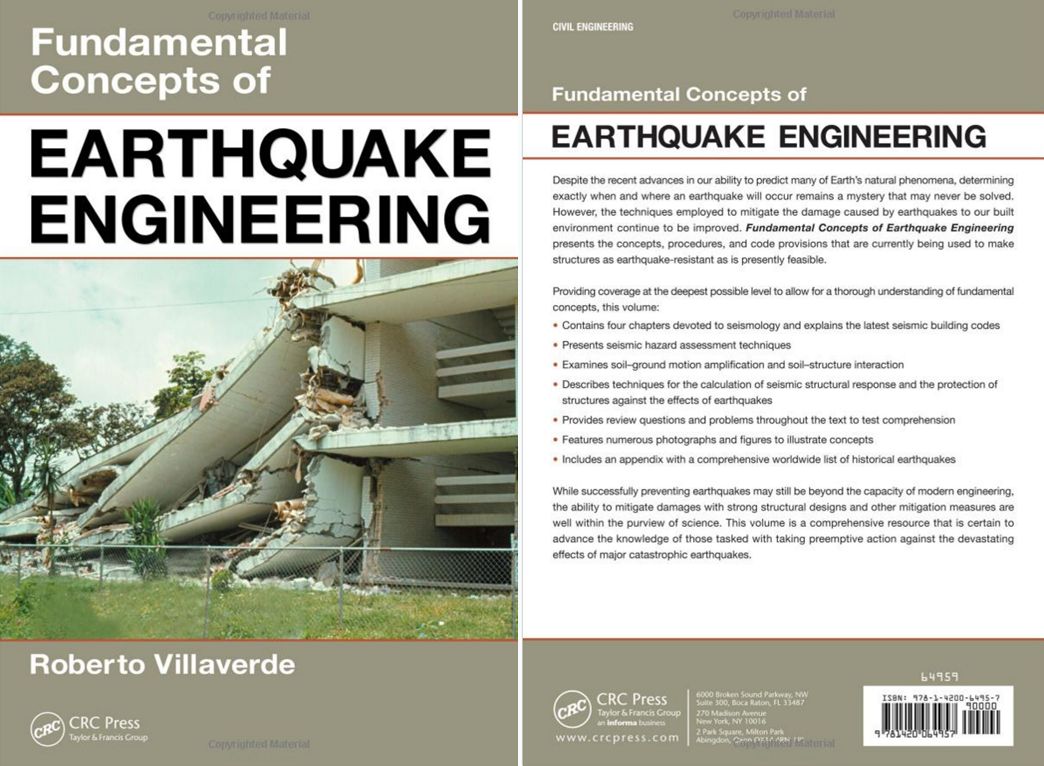

Fundamental Concepts of EARTHQUAKE ENGINEERING
Roberto Villaverde
نوع فایل ایبوک : PDF

Preface ...........................................................................................................................................xix
Author ......................................................................................................................................... xxiii
Chapter 1 Introduction ..................................................................................................................1
1.1 Importance of Earthquake Engineering ....................................................................................1
1.2 Damaging Effects of Earthquakes ............................................................................................1
1.3 Earthquake Forces ...................................................................................................................22
1.4 Design for Earthquake Forces .................................................................................................23
1.5 Defi nition and Scope ...............................................................................................................24
1.6 Historical Background ............................................................................................................27
Further Readings.............................................................................................................................27
2.1 Introduction .............................................................................................................................29
2.2 World Seismicity .....................................................................................................................30
2.3 Seismicity of United States ..................................................................................................... 32
2.4 Earthquake Statistics ............................................................................................................... 32
2.5 On-Line Seismicity Information .............................................................................................34
Further Readings............................................................................................................................. 35
3.1 Introduction .............................................................................................................................37
3.2 Types of Earthquakes ..............................................................................................................38
3.3 Earth Structure ........................................................................................................................39
3.4 Plate Tectonics Theory ............................................................................................................40
3.5 Plate Interaction, Formation of Earth’s Surface Features,
and Earthquake Generation ..................................................................................................... 42
3.6 Cause of Plate Movement ........................................................................................................ 45
3.7 Intraplate Earthquakes ............................................................................................................46
3.8 Earthquake Faults ....................................................................................................................46
3.9 Earthquake-Generation Mechanism: Elastic Rebound Theory ..............................................49
3.10 Focus, Epicenter, Rupture Surface, and Fault Slip .................................................................. 53
3.11 Foreshocks and Aftershocks ...................................................................................................54
3.12 Earthquake Prediction ............................................................................................................. 55
Further Readings............................................................................................................................. 61
4.1 Introduction .............................................................................................................................63
4.2 Longitudinal Waves in Long Rod ...........................................................................................63
4.3 Shear Waves in Long Shear Beam .......................................................................................... 74
4.4 Harmonic Waves ..................................................................................................................... 78
4.5 Waves in Long Flexural Beam: Wave Dispersion ...................................................................82
4.6 Elastic Waves in Unbounded Three-Dimensional Medium: P and S Waves ..........................86
4.7 Elastic Waves in Elastic Half-Space: Rayleigh Waves ............................................................99
4.8 Elastic Waves in Layered Half-Space: Love Waves .............................................................. 108
4.9 Refl ection and Refraction of Body Waves ............................................................................ 115
4.10 Attenuation of Wave Amplitude with Distance .................................................................... 122
Further Readings...........................................................................................................................125
Problems .......................................................................................................................................125
5.1 Introduction ........................................................................................................................... 129
5.2 Intensity Scales ..................................................................................................................... 129
5.3 Seismographs and Seismograms ........................................................................................... 134
5.4 Location of Earthquake Hypocenter ..................................................................................... 140
5.5 Magnitude Scales .................................................................................................................. 146
5.6 Seismic Moment and Moment Magnitude ............................................................................ 149
5.7 Accelerographs and Accelerograms...................................................................................... 154
Further Readings........................................................................................................................... 177
Problems ....................................................................................................................................... 177
6.1 Introduction ........................................................................................................................... 181
6.2 Peak Ground Acceleration .................................................................................................... 181
6.3 Strong-Motion Duration ........................................................................................................ 182
6.4 Response Spectrum ............................................................................................................... 182
6.5 Nonlinear Response Spectrum.............................................................................................. 196
6.6 Fourier Spectrum ..................................................................................................................207
6.9 Design-Spectrum-Compatible Time Histories .....................................................................228
Further Readings...........................................................................................................................230
Problems .......................................................................................................................................230
7.1 Introduction ...........................................................................................................................237
7.2 Identifi cation of Seismic Sources .......................................................................................... 239
7.3 Factors Affecting Ground Motion Characteristics at Site ....................................................244
7.4 Ground Motion Intensity at Given Site: Attenuation Laws ...................................................246
7.5 Magnitude-Recurrence Relationships ................................................................................... 261
7.6 Ground Motion Intensity in Given Time Interval .................................................................264
7.7 Semiprobabilistic Seismic Hazard Evaluation ...................................................................... 270
7.8 Probabilistic Seismic Hazard Evaluation .............................................................................. 275
7.9 Seismic Zonation Maps .........................................................................................................282
7.10 Microzonation Maps .............................................................................................................287
Further Readings...........................................................................................................................289
Problems .......................................................................................................................................289
8.3 Evaluation of Site Effects Using Statistical Correlations......................................................304
8.4 Evaluation of Site Effects Using Analytical Techniques ......................................................306
8.5 Determination of Shear Modulus and Damping Ratio ......................................................... 334
Further Readings........................................................................................................................... 347
Problems ....................................................................................................................................... 347
9.1 Introduction ........................................................................................................................... 353
9.2 Peak Ground Acceleration and Response Spectrum Shape Method .................................... 354
9.3 Newmark–Hall Approach .....................................................................................................360
9.4 Direct Statistical Correlations ............................................................................................... 375
Further Readings........................................................................................................................... 375
Problems ....................................................................................................................................... 376
10.1 Introduction ........................................................................................................................... 379
10.2 Modal Superposition Method ............................................................................................... 379
10.3 Maximum Structural Response Using Response Spectra ..............................................
10.6 Summary of Response Spectrum Method .......................................................................... 416
10.7 Response Spectrum Method Based on Modal Acceleration Method ................................. 423
10.8 Response Spectrum Method for Multicomponent Ground Motions ................................... 431
10.9 Response Spectrum Method for Spatially Varying Ground Motions .................................449
Further Readings...........................................................................................................................462
Problems .......................................................................................................................................462
11.1 Introduction .........................................................................................................................469
11.2 General Classifi cation .......................................................................................................... 470
11.3 Central Difference Method ................................................................................................. 470
11.4 Houbolt Method ................................................................................................................... 476
11.5 Constant Average Acceleration Method ..............................................................................482
11.6 Linear Acceleration Method ................................................................................................489
11.7 Wilson-θ Method ................................................................................................................. 495
11.8 Newmark-β Method .............................................................................................................500
11.9 Stability and Accuracy Issues .............................................................................................503
11.10 Analysis of Nonlinear Systems ........................................................................................... 513
11.11 Final Remarks ..................................................................................................................... 537
Further Readings........................................................................................................................... 539
Problems ....................................................................................................................................... 539
12.1 Introduction ......................................................................................................................... 541
12.2 Derivation of Procedure ...................................................................................................... 541
12.5 Nonlinear Static Procedure .................................................................................................565
Further Readings...........................................................................................................................568
Problems .......................................................................................................................................568
13.1 Problem Defi nition .............................................................................................................. 571
13.2 Kinematic and Inertial Interaction ...................................................................................... 572
13.3 Vibration of Foundations on Elastic Halfspace .................................................................. 574
13.4 Lumped-Parameter Models ................................................................................................. 591
13.5 Coupled Rocking and Horizontal Vibrations of Rigid Circular Foundations .................... 598
13.6 Vibration of Rigid Circular Foundations Supported by Elastic Layer ................................603
13.7 Vibration of Embedded Foundations ..................................................................................605
13.8 Foundation Vibrations by Method of Impedances .............................................................. 610
13.9 Material or Internal Damping in Soils ................................................................................ 621
13.10 Vibrations of Foundations on Viscoelastic Halfspace ........................................................624
13.11 Simplifi ed Equivalent Single-Degree-of-Freedom System Method ................................... 627
13.12 Advanced Methods of Analysis .......................................................................................... 637
13.13 Experimental Verifi cation ...................................................................................................645
Further Readings ...........................................................................................................................646
Problems .......................................................................................................................................647
14.1 Introduction .........................................................................................................................649
14.2 Importance of Nonstructural Elements ...............................................................................649
14.3 General Physical Characteristics ........................................................................................ 653
14.4 General Response Characteristics.......................................................................................654
14.5 Modeling of Nonstructural Elements ..................................................................................654
14.6 Methods of Analysis ........................................................................................................... 655
14.7 Floor Response Spectrum Method ......................................................................................656
14.8 Modal Synthesis Method ....................................................................................................663
Problems .......................................................................................................................................686
15.1 Introduction .........................................................................................................................689
15.2 Basic Concept ......................................................................................................................689
15.3 Historical Perspective ......................................................................................................... 691
15.4 Isolation Bearings ...............................................................................................................695
15.5 Methods of Analysis ...........................................................................................................706
Problems ....................................................................................................................................... 749
16.1 Introduction ......................................................................................................................... 753
16.2 Basic Concepts .................................................................................................................... 754
16.3 Energy Dissipating Devices ................................................................................................760
16.4 Analysis of Structures with Added Dampers...................................................................... 785
16.5 Implementation Issues ......................................................................................................... 810
Further Readings........................................................................................................................... 812
Problems ....................................................................................................................................... 812
17.1 Introduction ......................................................................................................................... 815
17.2 General Requirements......................................................................................................... 816
17.3 Design Ground Motion ....................................................................................................... 821
17.4 Analysis Procedures ............................................................................................................ 835
17.5 Simplifi ed Method...............................................................................................................840
17.7 Modal Response Spectrum Analysis ..................................................................................850
17.8 Linear Response Time-History Analysis ............................................................................ 852
17.9 Nonlinear Response Time-History Analysis ......................................................................854
17.10 Soil–Structure Interaction Effects ...................................................................................... 862
17.11 Nonstructural Components ................................................................................................. 872
17.12 Base-Isolated Structures .....................................................................................................880
Problems ........................................................................................................................................ 921
Appendix ......................................................................................................................................929
Index .............................................................................................................................................939
کتاب لاتین مفاهیم اساسی مهندسی زلزله - Fundamental Concepts of EARTHQUAKE ENGINEERING








